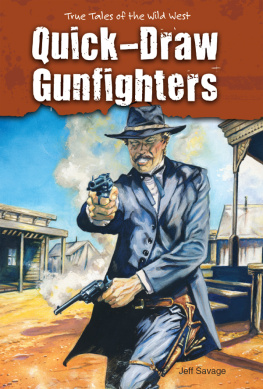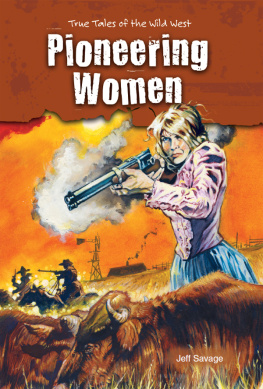BLAZING TRAILS IN THE WILD WEST!
Kit Carson fired his rifle, killing an elk. The young scout walked over to bag his prize. Without warning, two grizzly bears emerged from the trees. Carson ran as fast as he could. He escaped the bears but lost the elk. Scouts like Kit Carson had to be ready for anything on the wild frontier. Americans eager to move west needed help getting there. While famous explorers got the credit for discovering trails, they could not have done it without the leadership of scouts. Author Jeff Savage explores the fearless scouts, who opened up the West for others to follow.
About the Author
Jeff Savage has written more than two hundred books for students. Jeff lives with his wife, Nancy, and sons, Taylor and Bailey, in El Dorado Hills, a stone's throw from where gold was discovered in California.

Kit Carson raised his rifle, took careful aim, andbang!blasted a bullet right into the elk. The animal collapsed to the ground, dead on the spot. Carson was pleased to have bagged some food at last. It had been several days since he and his trapper friends had eaten meat.
Carson was a twenty-six-year-old explorer working as a scout in the Black Hills of what is now South Dakota. The year was 1835, and the land in which Carson found himself was part of the howling wilderness of the West. Only a handful of white people knew much about the land west of the Mississippi River, or about how to survive in such terrain. Kit Carson was one of them.
The trappers for whom Carson worked had been hunting for beaver pelts. It was Carsons responsibility as scout to be the eyes and ears of his group. He had to guide the trappers through rugged country, fetch food for them, and keep them from harm. Whats more, there were plenty of ferocious animals prowling about, as Carson was about to discover.
Carson leaned over to inspect the dead elk. All at once, he heard a terrific roar from behind him. He snapped his head around, and there they weretwo large grizzly bears, charging right at him!
Carson had already fired his gun, and he had no time to reload it. He spotted a nearby pine tree and made a run for it. The grizzliesin hot pursuitwere at his feet when he reached the tree. He dropped his gun and leaped to the safety of a tree limb just in time. I had to drop my gunthe bears rushing for me, I had to make all haste to ascend the tree, Carson later explained.
With his gun lying on the ground at the grizzlies feet, Carson had no choice but to sit in the tree and hope the bears would leave. One grizzly lost interest quickly, but the other stayed. It pawed at Carson, who couldnt climb any higher. To protect himself, Carson broke off a tree branch and used it to hit the bear on the snout each time it got too close. The bear snarled and growled. The sky grew dark as night arrived. It wasnt until midnight that the grizzly got bored and wandered away. Carson dropped down from the tree, picked up his gun, and dashed the mile back to camp.

Image Credit: 2011 Clipart.com, a division of Getty Images
While out hunting for elk, Kit Carson was attacked by two grizzly bears. One quickly left, but Carson had to fend off the other snarling bear for hours, seeking safety in a tree.
The trappers were thrilled to see him. They had feared that he was lost, or worse, dead. Carson told them about the grizzly bears and said that he had never been so scared in all my life. With the bears still lurking, Carson didnt dare to go back for the elk. The trappers wouldnt have meat for supper again that night, but they didnt mind. Their scout was safe.

Image Credit: Library of Congress Prints and Photographs
Kit Carson was a brave scout. He led many trappers and explorers through the Western frontier. This photo of Carson was taken later in his life.
Carson had always wanted to be a scout. He grew up listening to stories about Daniel Boone, a scout from Kentucky. Even before the Declaration of Independence was written in 1776, Boone was making history in America as a great explorer. He blazed a trail known as the Wilderness Road. Young Kit Carson wanted to be a frontiersman like Boone.
When the first white settlers arrived in America, they met both friendly and unfriendly American Indians. Many settlers, such as the Pilgrims of Massachusetts, might not have survived without the help of American Indians. Later, in the French and Indian War, eastern American Indians took sides and served as guides for both the French and the British. The British and American troops in the Revolutionary War were led once again by American Indian scouts.
When the United States purchased Louisiana from France in 1803, the new nation nearly tripled in size. To back up its claim, the United States needed to settle the land quickly. The government encouraged people to establish homes in the frontier. At that time, however, western North America was still mostly unexplored by white settlers.
Meanwhile, the American Indians had been living on this land for thousands of years, and many of them did not welcome the westward expansion of white settlers. The American Indians wanted to keep their land, eventually fighting settlers and soldiers in hundreds of bloody skirmishes. Yet the first scouts to lead the expansion were American Indians.
One of the first American expeditions through the West was aided by an American IndianSacagawea. Explorers Meriwether Lewis and William Clark are famous for their travels through the Pacific Northwest in 18041806. Their names might not be known today if not for the help of Sacagawea.
Sacagawea was a Shoshone woman who had been purchased and married by a French-Canadian trader named Toussaint Charbonneau. With Jean-Baptiste, their newborn son, Charbonneau and Sacagawea joined the Lewis and Clark expedition. Charbonneau was hired as an interpreter, and Sacagawea was hired as a guide.
The mere presence of Sacagawea and her baby saved the Lewis and Clark expedition from attack countless times. American Indians knew upon seeing a woman and a baby that the group was not a war party. Eventually, the expedition reached its goalthe Pacific Ocean.
The same year that Lewis and Clark completed their journey, explorers Zebulon Pike and Stephen H. Long began leading U.S. Army expeditions through the same wilderness that the Lewis and Clark expedition had traveled.
The tales of early scouts spread through the towns of the eastern United States. People soon realized the significance of the land west of the Mississippi River and began to head west. They knew about the dangers that lurked in the vastness of the West, but they knew little about the land itself. For instance, the pioneers in the first wagon train to the West Coast in 1841 knew only that Oregon lay somewhere to the west. They did not know how long the trip would take, nor did they know whether they would survive the mountains or scorching deserts along the way. Scouts were needed more than ever.
Trappers joined American Indians in providing their services to whoever hired them. Many of them lived among the American Indians and had adapted to their ways of life. The American Indians taught the trappers how to survive on their own. These skills were invaluable to the pioneers.


















